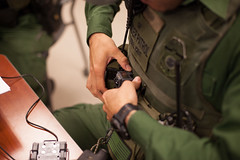Deployment will test cameras in 9 areas of operation
WASHINGTON – U.S. Customs and Border Protection (CBP) today announced the start of a six-month testing period of Incident Driven Video Recording System (IDVRS) in operational environments. Agents and officers will evaluate the use of this technology, which includes body-worn cameras and

worn camera
vehicle-mounted cameras, in each of CBP’s operational environments including along the U.S. border, at and between ports of entry, in the air and at sea. In support of its commitment to the public trust, integrity and transparency, CBP is continuing to press forward toward the use of cameras in the operational environment.
“CBP law enforcement personnel are charged with protecting the American people against terrorism and violent transnational criminals, while protecting the privacy and civil liberties of individuals with whom they interact and ensuring the safety of their fellow law enforcement partners,” said Commissioner Kevin McAleenan. “As the first federal law enforcement agency to complete a feasibility study of body worn cameras, we are now ready to deploy video cameras in border environments to evaluate their ability to document law enforcement encounters effectively.”
The IDVRS field evaluation will take place in nine operational environments, including:
- Land ports of entry - Detroit, Michigan and Eagle Pass, Texas;
- Airport – Atlanta, Georgia;
- Seaport – Long Beach, California;
- Border Patrol operations – Campo, California; Kingsville, Texas; Las Cruces, New Mexico; and
- Air Branch – Tucson, Arizona; and
- Marine Branch – West Palm Beach, Florida.
As an organization committed to continuous improvement, innovation, transparency and the highest standards of professionalism, CBP is pursuing new technologies. Through this deployment, CBP will evaluate whether IDVRS is a viable technology to deploy in the operational environments, including line watch, checkpoint, vessel interdiction, vessel boarding, airport, seaport, outbound and other environments as necessary. The goal of the study is to determine CBP's capability needs and gaps with documenting incidents and to enhance transparency of operations through the use of fixed, vehicle mounted, and body-worn cameras., while supporting officer safety.
Before fully implementing an IDVRS, CBP will need to address many practical policy and privacy questions as well as the significant financial costs associated with deployment, maintenance, video data storage, training, and technology upgrades.
CBP published a Privacy Impact Assessment to evaluate the privacy risks associated with the use of IDVRS at and between ports of entry which available on DHS.gov.
Check out our Flickr gallery of photos:


